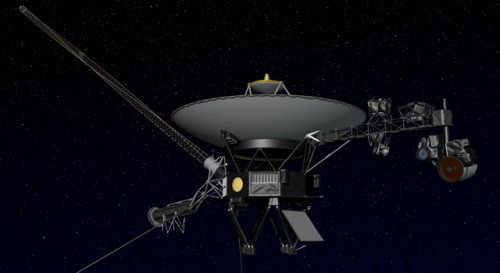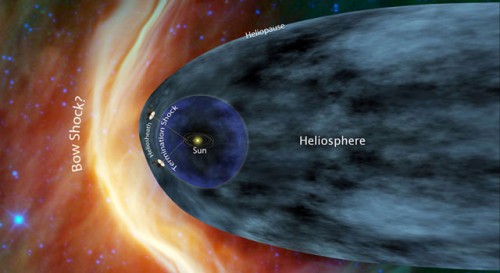By James Dacey

Artist’s concept of NASA’s Voyager spacecraft. (Courtesy: NASA/JPL-Caltech)
“It is the consensus of the Voyager science team that Voyager 1 has not yet left the solar system or reached interstellar space.”
That is what Voyager scientist Edward Stone had to say on the matter back in March following reports that NASA’s most intrepid explorer had finally passed beyond the edge of our solar system. Today, three new papers published in Science back up this statement, asserting that the Voyager 1 had instead entered a distinct section at the edge of the solar system.
Voyager 1 was launched with its partner craft Voyager 2 way back in 1977 with the initial aim of exploring the planets in the outer solar system. As early as 1979, Voyager 1 made its closest approach to Jupiter followed by its closest fly-by of Saturn the following year. Over the past three decades the craft has gradually drifted to the outer boundary of the heliosphere and into a region known as the heliosheath.
In recent years, astronomers have been getting excited about the imminent departure of Voyager. They say we will know for sure once the craft has left the heliosphere because it will no longer feel the influence of the Sun’s magnetic field; the instruments onboard Voyager will record a change in the direction of the background magnetic field.
In March this year, a paper published in Geophysical Research Letters noted that Voyager had recorded distinct changes in radiation levels during August 2012. The craft was suddenly being bombarded by higher intensities of galactic cosmic rays, while the intensity of cosmic rays – which get trapped in the Sun’s magnetic field – suddenly dropped off. Various news reports at the time raised the question of whether Voyager had finally left the building. But NASA responded by saying that Voyager was not yet in interstellar space but had entered a new region at the edge of the solar system.

The twin Voyager mission was launched in 1977. (Courtesy: NASA)
The papers published today describe this region as the “heliosheath depletion region”. The reports consider: measurements of the heliosphere’s magnetic field; measurements of energetic particles; and the balance between the low-energy ions from the heliosphere and the influx of cosmic rays. One of the key findings is that while the magnetic field has increased in intensity, it has not yet changed direction as would be expected had it left the solar system. This study, whose lead author is Leonard Burlaga of the NASA Goddard Space Flight Center, asserts that Voyager 1 “crossed the boundary of an unexpected region five times between days 210 and 238 in 2012”.
So it seems pretty clearcut then – Voyager was still in the solar system in August 2012. That may be so, but back in December, the previously mentioned NASA Voyager project scientist Edward Stone said that his best guess was that Voyager is likely just a few months to a couple of years away from leaving. So in this week’s Facebook poll we want you to answer the following question:
Has Voyager 1 left the solar system yet?
Yes
No
To take part please visit our Facebook page. And as always, please feel free to explain your response by posting a comment either on Facebook or below this blog entry.
In last week’s poll we asked: “Which type of large-scale facility has contributed the most to condensed-matter physics?” For the first time I can remember since we started running these polls two years ago the outcome was a dead heat, as 46% of respondents opted for synchrotron sources and 46% went for neutron sources. The remaining 8% went for “other”, which included the suggestion of “large-scale coffee-production facilities”. We hope to hear from you again this week.
A natural model for the morphology of the boundary between the heliosphere and interstellar space would be a fractal model featuring complex and multi-scaled inter-fingering of the two distinct domains.
Fractal boundaries are commonly observed in natural phenomena like the mixing of different fluids.
Such a model might help in understanding the complexity and variability of the observed phenomena.
Robert L. Oldershaw
http://www3.amherst.edu/~rloldershaw
Discrete Scale Relativity/Fractal Cosmology
Please, go beyond the “might” and try to do it and see where you reach.
I understand the question you want to make is whether Voyager 1 has left the heliosphere, and it looks that we don’t have enough evidence so far. I believe the study of this region deserves better attention, and plasma propelled spacecrafts will be needed to explore it in the future.
Is it possible from data given from satelite gain the speed of this satelite? The satelite speed is influenced by all planets and has special way in the solar system different from palanets moving around the Sun. Bouth satelites Voyager can communicate between themselsef and send data given from this communication to the Earth.
Can both Voyager satelites make stronger computer capacity by cooperation together?
Trackback: Blog - physicsworld.com
Trackback: Blog - physicsworld.com
Trackback: Blog - physicsworld.com